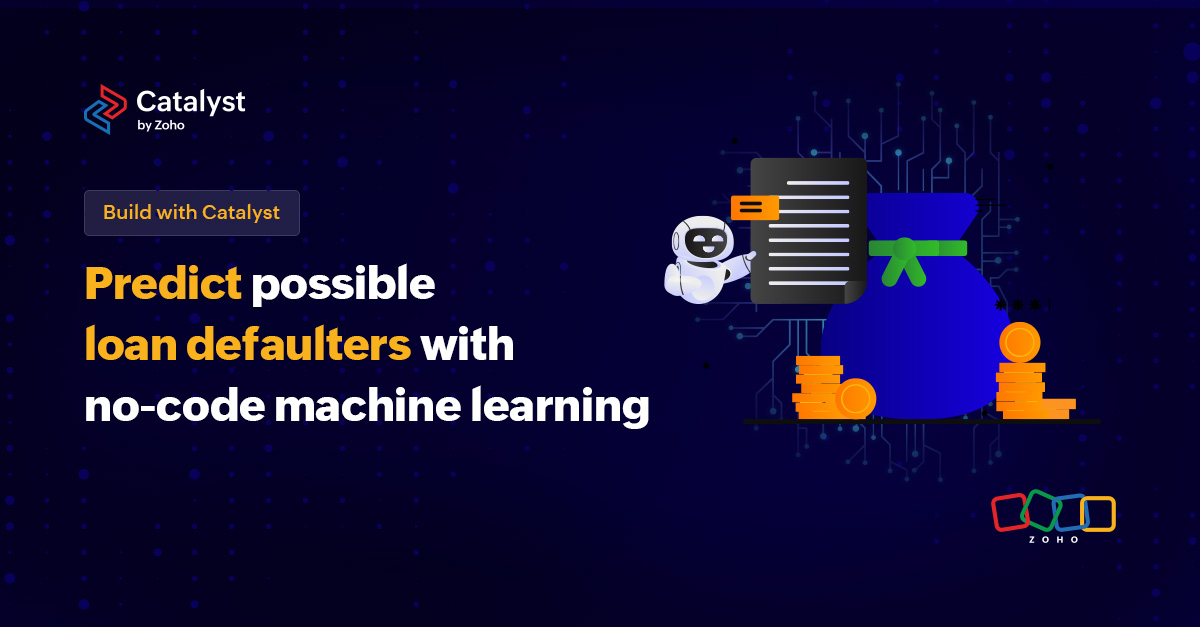- HOME
- Build with Catalyst: Predict possible loan defaulters with no-code machine learning
Build with Catalyst: Predict possible loan defaulters with no-code machine learning
- Last Updated : October 10, 2023
- 596 Views
- 3 Min Read

Dear Partners,
As part of the "Build with Catalyst" series, we'll cover an interesting use case to build an ML model using Catalyst QuickML that predicts possible defaulters by analyzing the receivable details of loan borrowers. While credit management helps companies determine credit limits for account receivables, embracing AI could help predict the likelihood of payment defaulting from a particular receivable customer.
What is Catalyst QuickML?
Catalyst QuickML is an end-to-end ML platform by Catalyst to build, train, evaluate, deploy, and optimize ML models, facilitating data-driven decision-making. With this no-code platform, we want to empower developers with or without ML expertise to create powerful yet custom ML models and harness the power of AI.
Minimize financial risks by predicting possible loan defaulters
Financial services firms can use Catalyst QuickML to build models that can accurately predict possible loan defaulters making lives easier for collection agents. Every organization that disburses consumer loans would have detailed information about the borrowers like demographics, bank balances, credit scores, payment schedules, loan closure status, and other relevant data points that can help in powering accurate predictions using QuickML.
For a financial services firm that disburses a large volume of loans, it is essential to prioritize loan collection based on factors like those nearing due dates, past due dates, days since the account was placed for collection, inward cheque returns, credit scores, payment behavior, among other considerations. Analyzing this information effectively can help identify cases of potential default before they happen. Categorizing borrowers into the following groups can be particularly helpful:
High value, high risk
High value, low risk
Low value, low risk
Low value, high risk
Once categorized, the company would share the details of each borrower with the requisite classification monthly to each collection team in their region. The collection team would now find it much easier to prioritize their loan collection effort and contact the high risk customers reducing the overall impact of defaulters on the overall loan book. You could easily build a high-quality ML model in QuickML as follows:
Upload the borrower details to Catalyst QuickML. This would include data like current income, credit score, loan type, collateral type, industry, size of customer, region, political affiliations, debt, payment frequency, and many more.
Build a pipeline to produce a model that identifies trends based on multiple behavioural data.
Establish an endpoint using QuickML when the model is ready. This endpoint will provide a REST API.
Query the created model (In step 3) each month with recent data from the borrower to predict the probability of defaulting a loan.
Use Catalyst Functions to classify each borrower into logical categories like "High value, high risk", "High value, low risk", "Low value, low risk", and "Low value, high risk".
Create a report as an email and push it to the respective debt collection team. Say, the "high-value, high-risk" groups could be handled by one collection team and other variations by another team. The respective team can now communicate with the borrowers in their desired mode of communication based on categorization.
This way, the debt collection team can proactively reach out to the possible loan defaulters in their desired mode of communication well ahead of time, thereby maximizing the ROI. QuickML helps your customers to take preventive measures and make informed decisions to safeguard their financial well-being by providing a comprehensive financial risk management solution with:
Catalyst QuickML
Catalyst FaaS
We'd love to hear about your journey with Catalyst QuickML. Put on your creative hat, and share possible use cases with QuickML. Feel free to share your thoughts in the comments section or drop us a line for a detailed 1:1 session to help you get started.